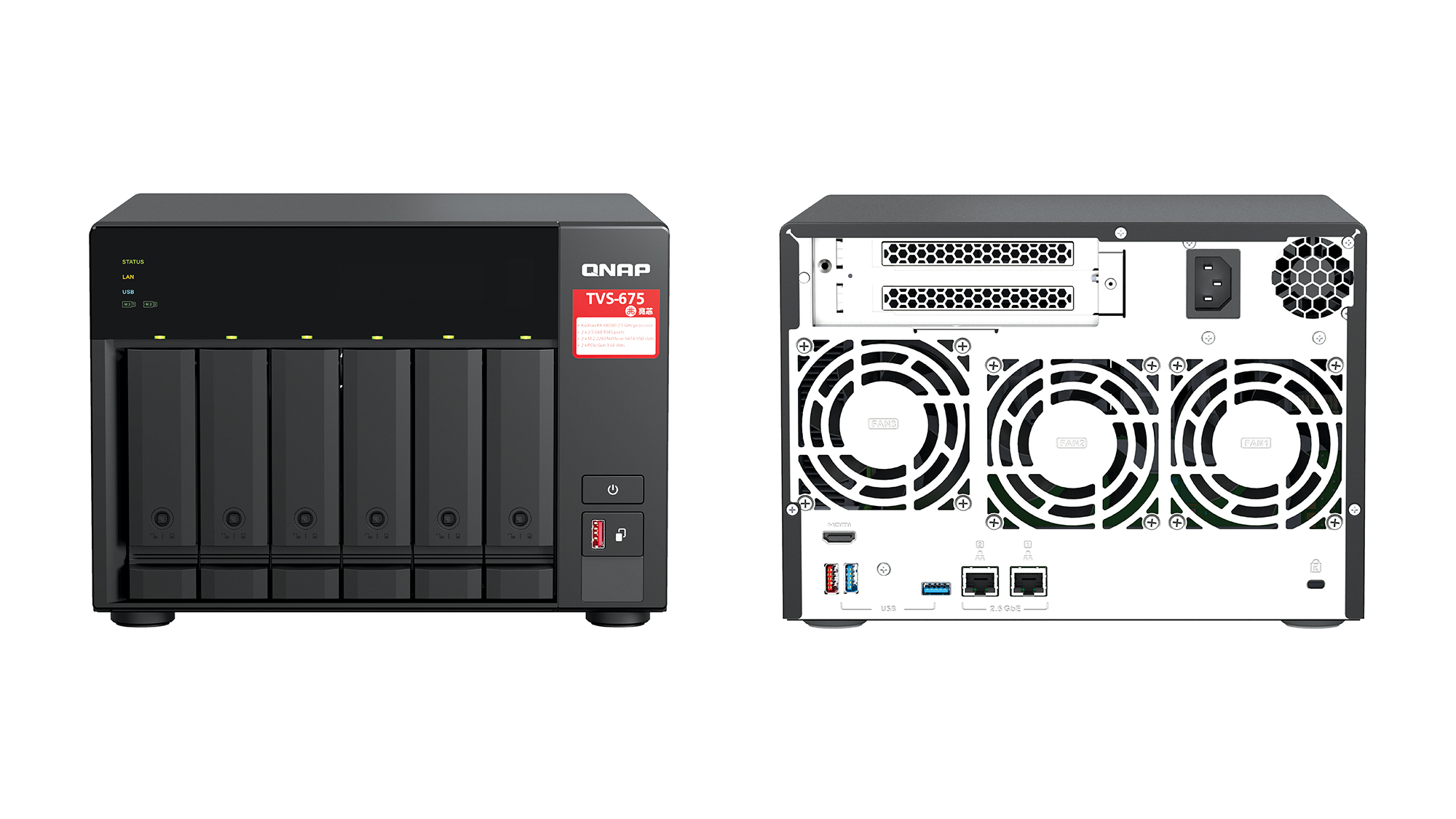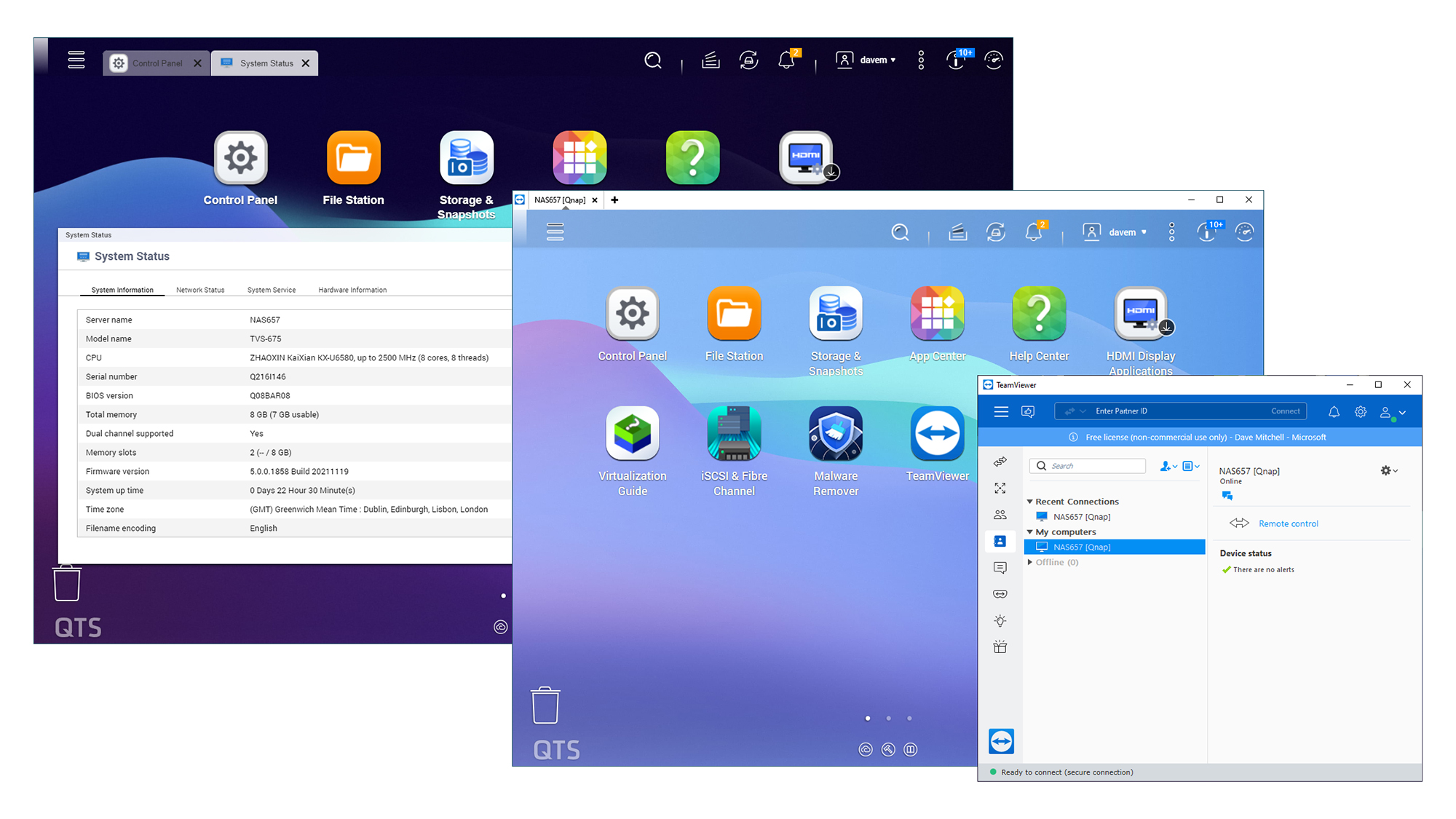Qnap TVS-675 review: Noteworthy, but not impressive
This desktop NAS has some great features and a novel choice of CPU – but the price is high for what you get

-
+
Strong complement of ports
-
+
Updated software
-
+
ExFAT option no longer costs extra
-
-
Expensive
-
-
Disappointing CPU performance
-
-
Middling IP SAN speeds

Qnap’s TVS-675 is an intriguing NAS appliance. While almost every other storage solution on the market runs on either Intel or AMD silicon, this desktop box gives Chinese x86 CPU manufacturer Zhaoxin its debut on the global stage, courtesy of an eight-core 2.5GHz KaiXian KX-U6580 SoC.
It’s the centrepiece of a very versatile specification. The TVS-675 comes with 8GB of base DDR4 non-ECC memory, which can be upgraded all the way up to 64GB using two 32GB SODIMM modules. The six front-facing SATA bays can support either LFF drives or SFF SSDs, while two internal M.2 NVMe SSD slots can be used to create a fast system pool or a performance-boosting cache.
Connectivity is strong, too. Storage is served up over dual embedded 2.5GbE multi-Gigabit ports, while a pair of PCI-E slots provide scope to upgrade to 10GbE or even Fibre Channel if you wish. And if multimedia is your thing, there’s also an HDMI 2 port capable of 4K video output, thanks to the CPU’s embedded ZhaoXin C-960 graphics processor.
As for the CPU itself, the name may be unfamiliar but you shouldn’t need to worry about compatibility issues. It runs standard 64-bit x86 code, so there’s no restriction on the apps it can run, nor on your choice of operating system: as with most Qnap appliances, when you first boot up the appliance its quick start wizard prompts you to choose between the standard QTS platform and the more advanced QuTS hero OS.
We opted for the former, to try out the new QTS 5 release. This brings an upgraded Linux kernel and a fresh look, with chunkier icons, a new alert noticeboard and a revamped status dashboard.

Access security has been tightened up, too, with support for TLS 1.3 HTTPS connections, an updated VPN app for more secure remote access and a new TeamViewer server app. The latter is easy to use: after installing the app on the appliance, we were able to add it to our TeamViewer account from the client’s nearby devices option, then use it to access the appliance remotely.
Storage features also see a few improvements. The exFAT option that Qnap used to charge for is now free, and the updated kernel increases performance for NVMe SSD caches. The promised Drive Analyser app has yet to be released, but this aims to provide advanced AI-based analytics on storage devices using the third-party ULink cloud service.
For performance testing, we fitted a dual-port fibre 10GbE card in the appliance and hooked it up to a Dell PowerEdge T640 Xeon Scalable tower running Windows Server 2019.
With four 14TB WD Red Plus NAS hard disks loaded in the tool-free carriers, the TVS-675 delivered very respectable NAS speeds, with Iometer reporting sequential read and write rates of 9.2Gbits/sec and 7.1Gbits/sec over a single 10GbE connection. Real-world performance was reasonable too, with copies of a 25GB test file between the NAS and server averaging read and write rates of 4.4Gbits/sec and 3.5Gbits/sec.
The system struggled more with encryption. The CPU does have an embedded AES-NI encryption engine, but when we tried copying our 25GB file to an encrypted share, performance fell to only 0.9Gbits/sec. IP SAN performance was also a mixed bag: a 500GB target mapped over a 10GbE connection gave us read and write rates of 9.2Gbits/sec and 6.5Gbits/sec respectively, which only increased to 11.7Gbits/sec and 6.9Gbits/sec with a dual 10GbE MPIO link.
The Zhaoxin CPU certainly makes the TVS-675 quite unique, but it doesn’t give it any obvious advantages – certainly not enough to justify the price tag of nearly £800. If you don’t need the HDMI port, the award-winning Qnap TS-873A will certainly suit you better: its AMD Ryzen processor delivers superior performance, it offers two extra drive bays, and it also costs £40 less.
Qnap TVS-675 specifications
| Chassis | Desktop chassis |
| CPU | 8-core 2.5GHz Zhaoxin KaiXian KX-U6580 SoC |
| Memory | 8GB DDR4 SODIMM (max 64GB) |
| Storage | 6 x LFF hot-swap drive bays, 2 x M.2 NVMe SSD slots |
| PSU | Internal 250W PSU |
| RAID support | Single, RAID 0, 1, 5, 6, 10, 50, 60, Triple Mirror, Triple Parity |
| Network | 2 x 2.5GbE |
| Other ports | 2 x PCI-E Gen3 x4 slots, 2 x USB-A 3.2 Gen 1, 2 x USB-A 3.2 Gen 2, HDMI 2 |
| Management | QTS/ QuTS hero |
| Dimensions (WDH) | 264 x 281 x 188mm |
| Warranty | 3yr hardware warranty |
Get the ITPro daily newsletter
Sign up today and you will receive a free copy of our Future Focus 2025 report - the leading guidance on AI, cybersecurity and other IT challenges as per 700+ senior executives
Dave is an IT consultant and freelance journalist specialising in hands-on reviews of computer networking products covering all market sectors from small businesses to enterprises. Founder of Binary Testing Ltd – the UK’s premier independent network testing laboratory - Dave has over 45 years of experience in the IT industry.
Dave has produced many thousands of in-depth business networking product reviews from his lab which have been reproduced globally. Writing for ITPro and its sister title, PC Pro, he covers all areas of business IT infrastructure, including servers, storage, network security, data protection, cloud, infrastructure and services.
-
 ‘Phishing kits are a force multiplier': Cheap cyber crime kits can be bought on the dark web for less than $25 – and experts warn it’s lowering the barrier of entry for amateur hackers
‘Phishing kits are a force multiplier': Cheap cyber crime kits can be bought on the dark web for less than $25 – and experts warn it’s lowering the barrier of entry for amateur hackersNews Research from NordVPN shows phishing kits are now widely available on the dark web and via messaging apps like Telegram, and are often selling for less than $25.
By Emma Woollacott Published
-
 Redis unveils new tools for developers working on AI applications
Redis unveils new tools for developers working on AI applicationsNews Redis has announced new tools aimed at making it easier for AI developers to build applications and optimize large language model (LLM) outputs.
By Ross Kelly Published
-
 Google layoffs continue with "hundreds" cut from Chrome, Android, and Pixel teams
Google layoffs continue with "hundreds" cut from Chrome, Android, and Pixel teamsNews The tech giant's efficiency drive enters a third year with devices teams the latest target
By Bobby Hellard Published